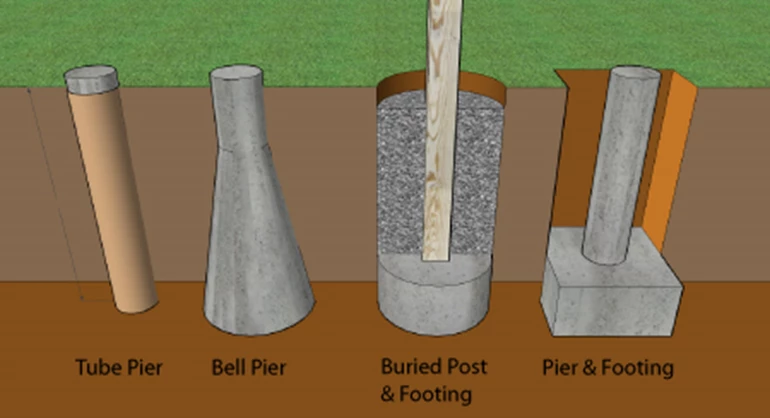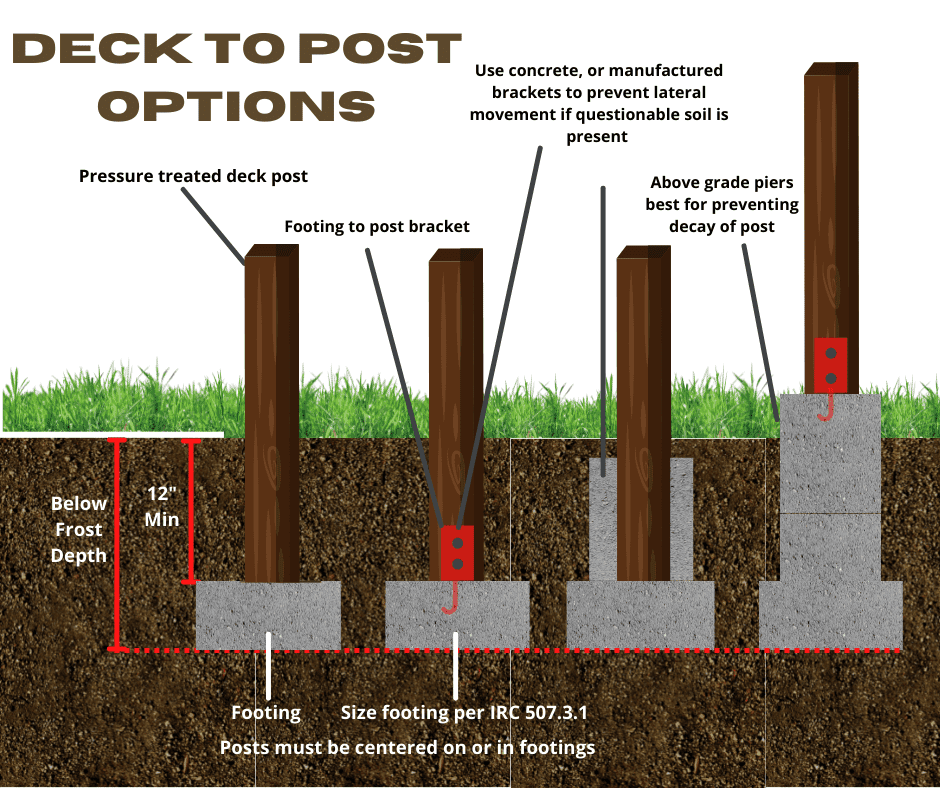Solid Foundations, Stunning Decks: The Ultimate Guide to Deck Footings
Wiki Article
Important Tips for Solid Deck Footing: A Comprehensive Guide
Welcome to "Important Tips for Solid Deck Footing: A Comprehensive Overview." In this comprehensive overview, we will give you with the vital expertise and methods to make certain a strong and steady foundation for your deck. Developing a deck is an investment that calls for mindful planning and focus to information, particularly when it involves the ground. This guide will certainly cover crucial elements such as selecting the appropriate products, assessing soil conditions, computing load ability, figuring out proper ground deepness, and accomplishing accurate installation. By adhering to these ideas, you will be outfitted with the required details to construct a deck that not just improves your exterior room however likewise stands the test of time. Let's dive right into the world of strong deck footing and develop a foundation you can count on.Choosing the Right Deck Footing Products
When choosing the best deck ground products, it is important to take into consideration the specific needs and demands of your task. The quality and longevity of the footings directly affect the security and long life of the deck framework. When selecting deck footing materials., there are several aspects to take into consideration.One important consideration is the sort of soil in your area. Various soil kinds have differing load-bearing abilities and drainage homes. As an example, clay soils have a tendency to retain water, while sandy dirts drain rapidly. Understanding your dirt problems will help you choose grounds that can properly support the weight of the deck and avoid concerns such as sinking or heaving.
An additional aspect to think about is the environment in your area. Extreme temperature levels, dampness levels, and freeze-thaw cycles can affect the efficiency of deck grounds. In cold environments, for circumstances, frost heave can trigger footings to break or change. In such situations, using frost-resistant products or setting up footings listed below the frost line can assist mitigate these dangers.
In addition, the size and design of your deck must also affect your choice of footing products. Larger or more complicated decks may need deeper or strengthened grounds to make sure adequate support. Recognizing the certain lots demands of your deck will certainly assist you establish the suitable products to use.
Eventually, selecting the best deck ground materials includes mindful consideration of aspects such as dirt conditions, environment, and deck style. By taking these factors into account, you can choose footings that supply the needed support, boost the security of your deck, and guarantee its long life.
Effectively Evaluating Soil Conditions
To correctly analyze soil problems for your deck ground, it is essential to thoroughly analyze the load-bearing capabilities and water drainage homes of the soil in your location. Comprehending the dirt's capability to bear weight and its capability to drain pipes excess water will assist guarantee the stability and durability of your deck.When evaluating the load-bearing ability of the dirt, it is necessary to consider elements such as dirt compaction, type, and density. Various soil types have varying load-bearing capabilities, with compacted soils generally providing better support than sandy or loose dirts. Conducting a soil test can provide beneficial information concerning the dirt's capacity to sustain the weight of your deck.
Furthermore, reviewing the drain residential properties of the soil is important to avoid water buildup and possible damage to your deck - Deck Footings. Poor drain can bring about moisture buildup, which can weaken the foundation and create structural issues. It is essential to assess the dirt's capability to drain water properly to avoid these problems
Consulting with a professional designer or soil specialist can significantly aid in correctly examining soil conditions for your deck footing. They can supply experienced guidance and support, ensuring that you pick the suitable footing layout and products based on the certain qualities of the soil in your location. Taking the time to extensively assess soil conditions will aid you construct a strong and long lasting deck.
Calculating Tons Capability for Grounds
One crucial action in ensuring the security of your deck is to properly calculate the tons capability for your grounds. Deck Footings. The tons capability refers to the optimum quantity of weight or load that the footings can safely sustain without creating any structural damage or failing. Computing the lots capability for grounds involves thinking about different aspects such as the size and sort of grounds, the kind of soil, the dimensions and weight of the deck, and the online load and dead lots that the deck will go throughTo compute the lots capacity, it is essential to get in touch right here with local building codes and guidelines as they give specific guidelines and requirements for deck building. These codes think about variables such as dirt bearing capacity, frost depth, and minimum footing dimensions. Additionally, it is important to engage the services of a specialist service provider or an architectural designer that can do the needed estimations and analyses to make sure the safety and security and security of the deck.
When determining the tons capability, it is necessary to properly figure out the online tons and dead tons that the deck will experience. The live lots describes the weight of individuals, furniture, and any other things that will certainly be positioned on the deck, while the dead tons refers to the weight informative post of the deck itself. By accurately identifying these loads and considering all relevant variables, you can make certain that your grounds are effectively created to support the weight and keep the security of your deck.
Making Sure Appropriate Footing Deepness
Appropriate footing depth is crucial for making certain the security and durability of your deck. The depth at which the footings are set up straight affects the architectural honesty of the deck, as it establishes how well the grounds can resist the forces applied by the deck and the dirt under it.When identifying the suitable ground deepness, several variables have to be thought about. These consist of the kind of dirt, the local environment, and the load ability required for the deck. Usually, footings must be placed listed below the frost line to stop any type of heaving or shifting because of cold and thawing cycles. In areas with large clay soil, deeper grounds may be required to give sufficient assistance.
To establish the proper footing depth, it is advised to speak with a structural engineer or building examiner that can assess the specific conditions of your website and supply advice based on local building ordinance and guidelines. They will certainly consider factors such as soil structure, water table level, and expected tons to figure out the minimum needed ground deepness.
Installing Footings With Accuracy
Mounting grounds with precision is necessary for making certain the security and structural integrity of your deck. Effectively set up footings offer a solid structure, making certain that your deck can stand up to the weight of furniture, people, and various other lots. To set up footings with accuracy, there are numerous crucial steps to adhere to.To start with, it is very important to precisely mark the area of each footing. This can be done by using a string or chalk line to develop a clear rundown. By determining and marking the specific settings, you can ensure that the grounds are uniformly spaced and aligned.
Following, you need to dig the openings for the footings. It is crucial to dig them to the proper depth and size, as specified by neighborhood building regulations and regulations. This will certainly offer ample support and prevent the deck from shifting or sinking with time.
When the openings are dug, it is essential to degree and small the dirt at the end of each opening. This will produce a stable base for the footing to sit on and stop any settling or motion.
After preparing the holes, you can proceed with pouring the concrete. Use a concrete mix that appropriates for grounds and follow the supplier's directions for pouring and mixing. Make Website certain that the concrete fills the openings completely and is level with the ground surface area.
Lastly, enable the concrete to heal properly before continuing with the construction of your deck. This will make sure that the grounds are secure and solid, providing a safe structure for your deck.

Conclusion
Finally, guaranteeing solid deck footing is crucial for the stability and long life of a deck framework. By picking the proper footing materials, assessing soil problems, computing tons capability, and installing grounds with accuracy, the danger of structural failing can be decreased. Adhering to these necessary pointers will certainly assist produce a strong structure for any type of deck project.Understanding your dirt conditions will aid you select footings that can properly support the weight of the deck and prevent concerns such as heaving or sinking.
Consulting with an expert designer or dirt expert can substantially help in properly analyzing soil conditions for your deck ground. Calculating the lots capacity for grounds includes taking into consideration different factors such as the dimension and type of grounds, the type of dirt, the dimensions and weight of the deck, and the real-time load and dead lots that the deck will be subjected to.

Report this wiki page